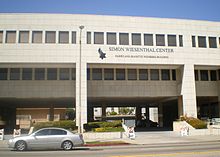Simon Wiesenthal
He played a small role in locating Adolf Eichmann, who was captured by Mossad in Buenos Aires in 1960, and worked closely with the Austrian justice ministry to prepare a dossier on Franz Stangl, who was sentenced to life imprisonment in 1971.
Shortly after Bruno Kreisky was inaugurated as Austrian chancellor in April 1970, Wiesenthal pointed out to the press that four of his new cabinet appointees had been members of the Nazi Party.
In 1986, Wiesenthal was involved in the case of Kurt Waldheim, whose service in the Wehrmacht and probable knowledge of the Holocaust were revealed in the lead-up to the 1986 Austrian presidential elections.
[20] In his autobiographies, Wiesenthal tells how he was arrested on 6 July, but saved from execution by his former foreman, a man named Bodnar, who was now a member of the Ukrainian Auxiliary Police.
In exchange for providing details about the railways, Wiesenthal obtained false identity papers for his wife from a member of the Armia Krajowa, a Polish underground organisation.
In one such deportation, Wiesenthal's mother and other elderly Jewish women were transported by freight train to Belzec extermination camp and murdered in August 1942.
[27] According to Wiesenthal, on 20 April 1943, Second Lieutenant Gustav Wilhaus, second in command at the Janowska camp, decided to shoot 54 Jewish intellectuals in celebration of Hitler's 54th birthday.
[30][31] Wiesenthal did not mention either of these events—or Kohlrautz's part in them—when testifying to American investigators in May 1945, or in an affidavit he made in August 1954 about his wartime persecutions, and researcher Guy Walters questions their authenticity.
SS-Hauptsturmführer Friedrich Warzok, the new camp commandant, rounded up the remaining prisoners and transported them to Przemyśl, 97 kilometres (60 mi) west of Lvov, where he put them to work building fortifications.
[42] As it became clear that the former Allies were no longer interested in pursuing the work of bringing Nazi war criminals to justice, Wiesenthal persisted, believing the survivors were obliged to take on the task.
[43]Though most of the Jews still alive in Linz had emigrated after the war, Wiesenthal decided to stay on, partly because the family of Adolf Eichmann lived a few blocks away from him.
[47][48] Hoping to obtain information on Eichmann's whereabouts, Wiesenthal continuously monitored the remaining members of the immediate family in Linz until they vanished in 1952.
[50] Fritz Bauer, prosecutor-general of the state of Hesse in West Germany, received independent confirmation of Eichmann's whereabouts in 1957, but German agents were unable to find him until late 1959.
Successes included locating and bringing to trial Erich Rajakowitsch [de], responsible for the deportation of Jews from the Netherlands,[57] and Franz Murer, the commandant of the Vilna Ghetto.
[58] In 1963 Wiesenthal read in the newspaper that Karl Silberbauer, the man who had arrested famed diarist Anne Frank, had been located; he was serving on the police force in Vienna.
[59] Despite Wiesenthal's protests, in late 1963 his centre in Vienna was taken over by a local community group, so he immediately set up a new independent office, funded using donations and his stipend from the Mossad.
Funding for trials was inadequate, as the governments of Austria and Germany became less interested in obtaining convictions for wartime events, preferring to forget the Nazi past.
[67] Concerned that Stangl would be warned and escape, Wiesenthal quietly prepared a dossier with the assistance of Austrian Minister of Justice Hans Klecatsky.
Wiesenthal's publishers advertised that he had been responsible for locating over 800 Nazis, a claim that had no basis in fact but was nonetheless repeated by reputable newspapers such as the New York Times.
[70] Stangl was sentenced to life in prison and died of heart failure in June 1971, having confessed his guilt to biographer Gitta Sereny the previous day.
[73] Wiesenthal was first told about Braunsteiner in early 1964 via a chance encounter in Tel Aviv with someone who had seen her performing selections at Majdanek—deciding who was to be assigned to slave labour and who was to murdered immediately in the gas chambers.
[84] Wiesenthal claimed to have information that placed Mengele in several locations: on the Greek island of Kythnos in 1960,[85] Cairo in 1961,[86] in Spain in 1971,[87] and in Paraguay in 1978, the latter 18 years after he had left.
[95] Shortly after Bruno Kreisky was inaugurated as Austrian chancellor in April 1970, Wiesenthal pointed out to the press that four of his new cabinet appointees had been members of the Nazi Party.
In an address in June, Kreisky's Minister of Education and Culture Leopold Gratz characterised Wiesenthal's Documentation Centre of the Association of Jewish Victims of the Nazi Regime as a private spy ring, invading the privacy of innocent parties.
In the book, Wiesenthal put forward his theory that Christopher Columbus was a Sephardi Jew from Spain who practised his religion in secret to avoid persecution.
Wiesenthal argued that the quest for the New World was not motivated by wealth or fame, but rather by Columbus's desire to find a place of refuge for the Jews, who were suffering immense persecution in Spain at the time (and in 1492 would be subjected to the Edict of Expulsion).
Wiesenthal also believed that Columbus's concept of "sailing west" was based on Biblical prophecies (certain verses in the Book of Isaiah) rather than any prior geographical knowledge.
Fellow Holocaust survivor and author Elie Wiesel, also nominated, began a campaign in hopes of winning the prize, travelling to France, Ethiopia and Oslo for speaking tours and humanitarian work.
[136] Daniel Finkelstein described Walters's research in Hunting Evil as impeccable and quoted Ben Barkow: "Accepting that Wiesenthal was a showman and a braggart and, yes, even a liar, can live alongside acknowledging the contribution he made".
The figure of eleven million Nazi victims became popular and was referred to by President Jimmy Carter in the executive order establishing the United States Holocaust Memorial Museum.




